Introduction
The ketogenic diet has gained significant attention as a transformative approach to nutrition, characterized by its unique high-fat, low-carbohydrate framework. By drastically reducing carbohydrate intake and replacing it with fats, the body enters a state known as ketosis, where it becomes efficient at burning fat for energy.
This article delves into the fundamentals of the keto diet, essential foods to include, effective meal planning strategies, common pitfalls to avoid, and methods for tracking progress.
With an understanding of these key components, individuals can navigate their ketogenic journey with confidence, unlocking potential benefits for weight loss and overall health.
1. Understanding the Basics of the Keto Diet
The composition of the keto diet is characterized by high-fat, moderate-protein, and very low-carbohydrate content. By significantly lowering carbohydrate intake and substituting it with fat, the keto diet allows the body to enter a metabolic state known as ketosis. In this state, the body becomes adept at metabolizing fat for energy, converting it into ketones in the liver, which subsequently serve as an alternative energy source for the brain.
This fundamental understanding is crucial as it supports the changes needed for adopting this eating plan. Typically, the macronutrient ratio in a low-carbohydrate eating plan comprises approximately:
- 70-75% fat
- 20-25% protein
- 5-10% carbohydrates
This distinctive shift in nutrient consumption is what sets the keto diet apart from other dietary approaches and is instrumental in its efficacy for weight loss and overall health enhancement.
Initial research indicates that the keto diet not only assists in fat burning but may also provide therapeutic advantages for conditions like multiple sclerosis, including decreases in body fat, fatigue, and inflammation. Significantly, the low-carbohydrate eating plan has been linked to longevity and healthspan enhancements in mice (Roberts et al., 2017). Furthermore, research indicates that higher dietary ratios of fat to carbohydrates (DKR) are linked to decreased all-cause mortality, particularly among women aged 60 and older with a BMI of 24 kg/m² or higher.
As stated by Popiolek-Kalisz J., 'Review Keto diet and cardiovascular risk - state of the art review,' this highlights the keto diet's potential health advantages, showcasing its relevance in the context of cardiovascular health.
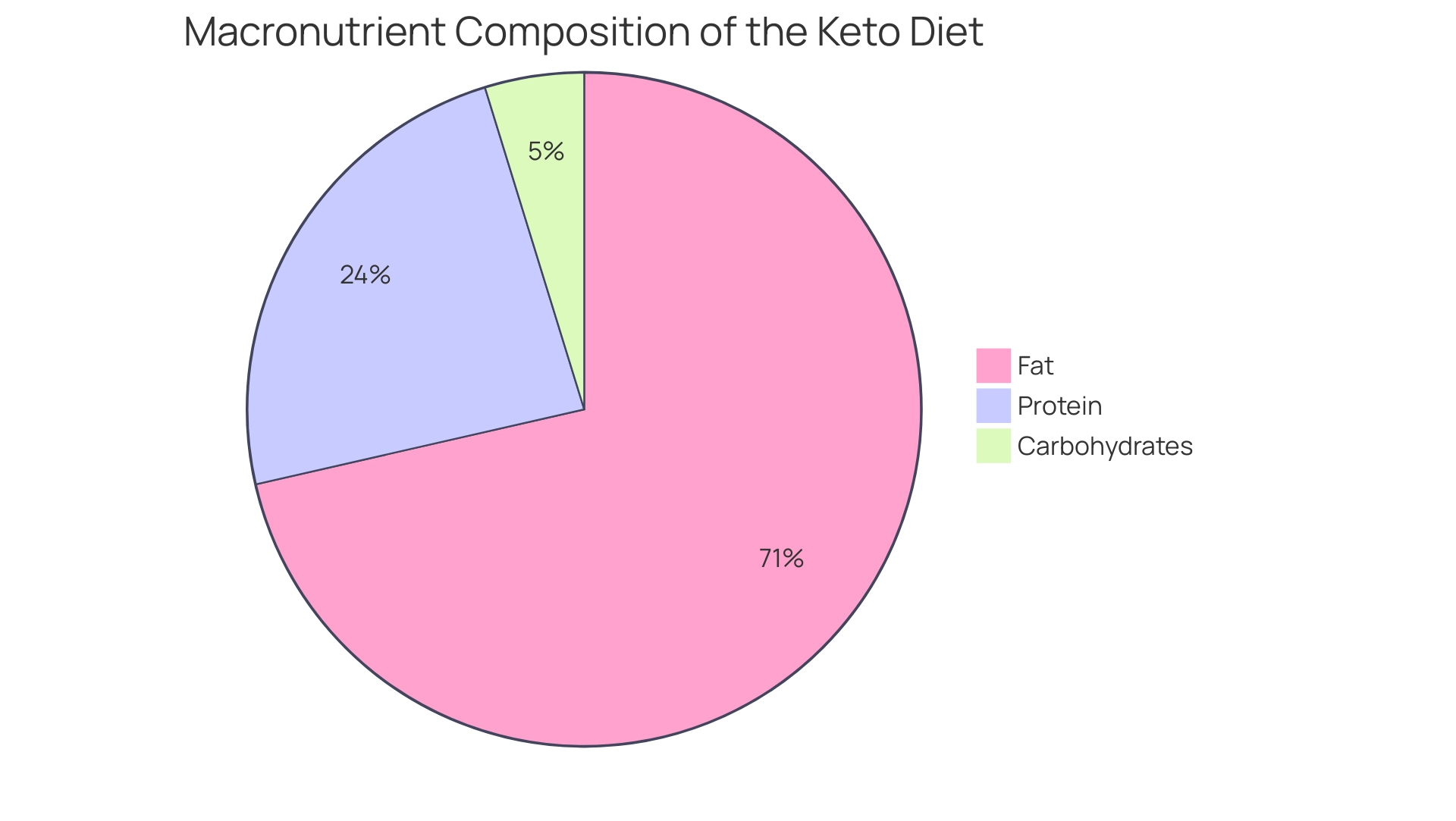
2. Essential Foods for Your Keto Journey
As you begin your keto diet journey, it's essential to incorporate a variety of nutrient-dense foods into your meals. Focus on the following key categories:
- Healthy Fats: Avocados, olive oil, coconut oil, butter, and nuts serve as excellent sources of healthy fats, helping you achieve your dietary fat targets crucial for ketosis.
- Proteins: Prioritize fatty cuts of meat, including ribeye steak, pork belly, and chicken thighs. Fatty fish, particularly salmon, is an outstanding protein source that aligns with the keto diet, along with low-carb vegetables such as leafy greens like spinach and kale, and cruciferous vegetables like broccoli and cauliflower. These options are low in carbohydrates but rich in essential nutrients.
- Dairy Products: Full-fat dairy, including cheese, heavy cream, and Greek yogurt, can be included in moderation, offering both flavor and nutritional benefits.
- Beverages: Hydration is vital; thus, water, herbal teas, and black coffee are recommended. It is advisable to steer clear of sugary drinks and limit alcohol intake to maintain optimal ketosis. Conversely, avoiding high-carbohydrate foods is critical for sustaining the state of ketosis while on the keto diet.
This includes grains, starchy vegetables such as potatoes and corn, sugary snacks, and most fruits. As emphasized in the case study on grains and starches, avoiding these foods is essential for sustaining a low-carb lifestyle, as their high carbohydrate content can surpass the daily limit of 50 grams. Additionally, incorporating dark chocolate that contains a minimum of 70% cocoa solids can be a suitable indulgence within your nutrition plan.
Acquainting yourself with these food groups not only promotes healthier eating options but also guarantees you stay in ketosis, thus enhancing the advantages of the keto diet. As mentioned by Popiolek-Kalisz J., grasping the effects of dietary selections on cardiovascular wellness is crucial, emphasizing the significance of choosing suitable foods while adhering to a low-carbohydrate lifestyle.
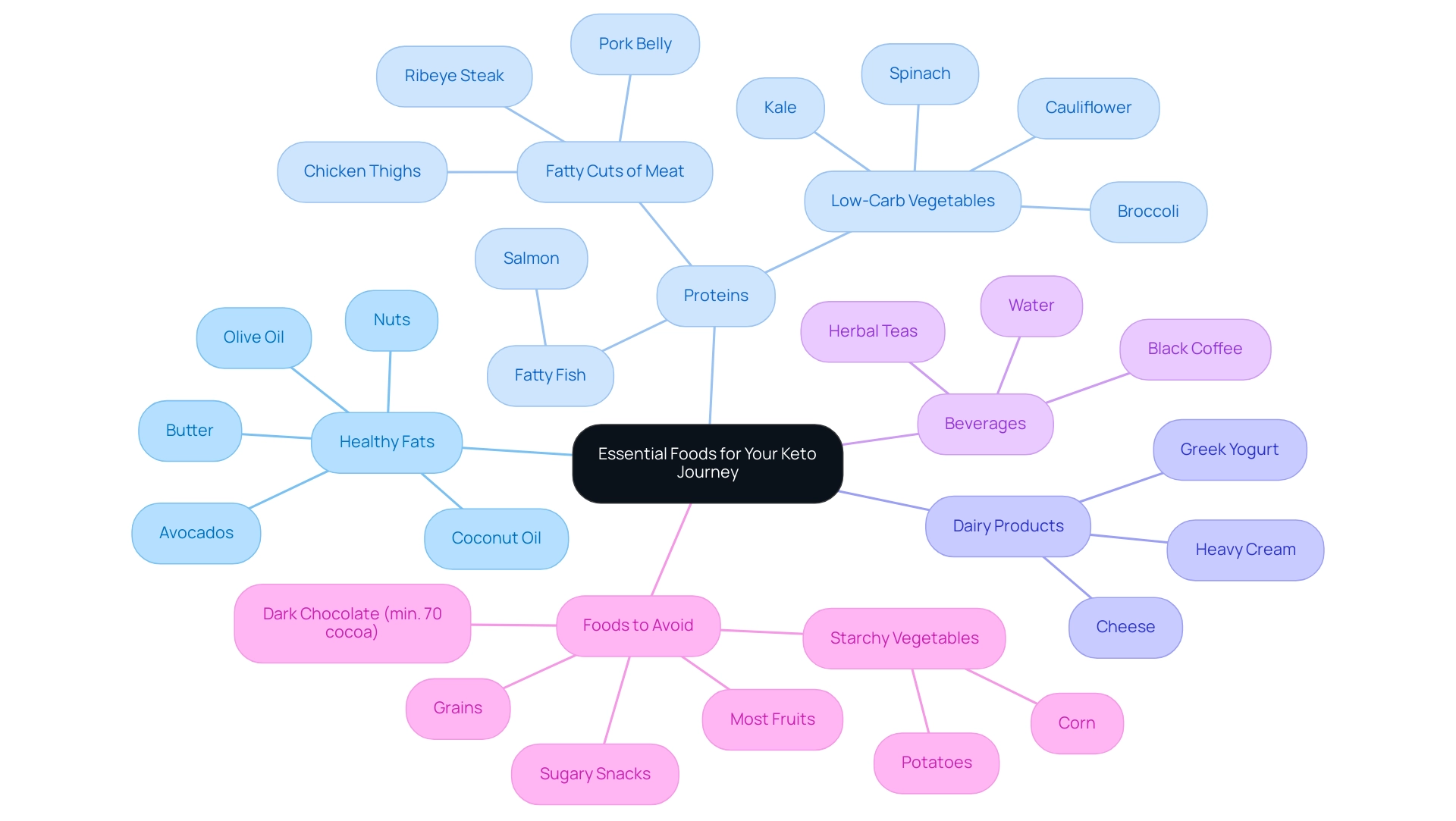
3. Meal Planning for the Keto Diet
Effectively planning meals on the low-carb diet involves several strategic steps:
-
Create a Weekly Menu: Develop a comprehensive menu for the week that encompasses breakfast, lunch, dinner, and snacks. This organized approach not only streamlines your shopping but also ensures that all necessary ingredients are readily available for your planned meals.
-
Batch Cooking: Prepare substantial servings of meals that are keto diet-friendly and can be stored for later consumption. Dishes such as casseroles, soups, and stir-fries are particularly well-suited for batch cooking, allowing for easy reheating and portion control.
-
Utilize resources for keto diet recipes by exploring a variety of cookbooks, blogs, and online communities dedicated to ketogenic recipes. These resources can provide valuable inspiration and introduce new meal ideas that align with your dietary goals.
-
Track Your Macros: Consistently monitor your macronutrient intake using an application or a food diary. This practice is crucial for maintaining your intake within the designated ratios and preventing inadvertent carbohydrate overconsumption, which can hinder your progress. Studies indicate that eighty-eight percent of participants in a two-phase eating regimen were compliant, underscoring the importance of diligent tracking.
-
Stay Flexible: While meticulous planning is essential, it is equally important to remain adaptable. Be prepared to modify your meals based on ingredient availability and personal preferences. This adaptability is essential for maintaining the low-carbohydrate lifestyle over the long haul.
Furthermore, as highlighted by Goldenberg et al., notable advantages in weight reduction, blood sugar regulation, and insulin sensitivity were seen in the short term for individuals following the keto diet. To further enhance your ketogenic journey, consider connecting with a certified nutritionist at Awesome Health Club. Our professionals provide personalized nutrition support tailored to your weight management, diabetes, and holistic wellness needs. They can assist with various topics, including weight management strategies, diabetes management, and chronic condition support. Schedule your free consultation today to gain expert insights and guidance.
However, it is crucial to be aware of the cautions and contraindications associated with this nutritional plan, particularly for individuals with diabetes or specific metabolic disorders. Adjustments in medication may be necessary to prevent severe hypoglycemia, highlighting the need for medical supervision when adopting this dietary approach.
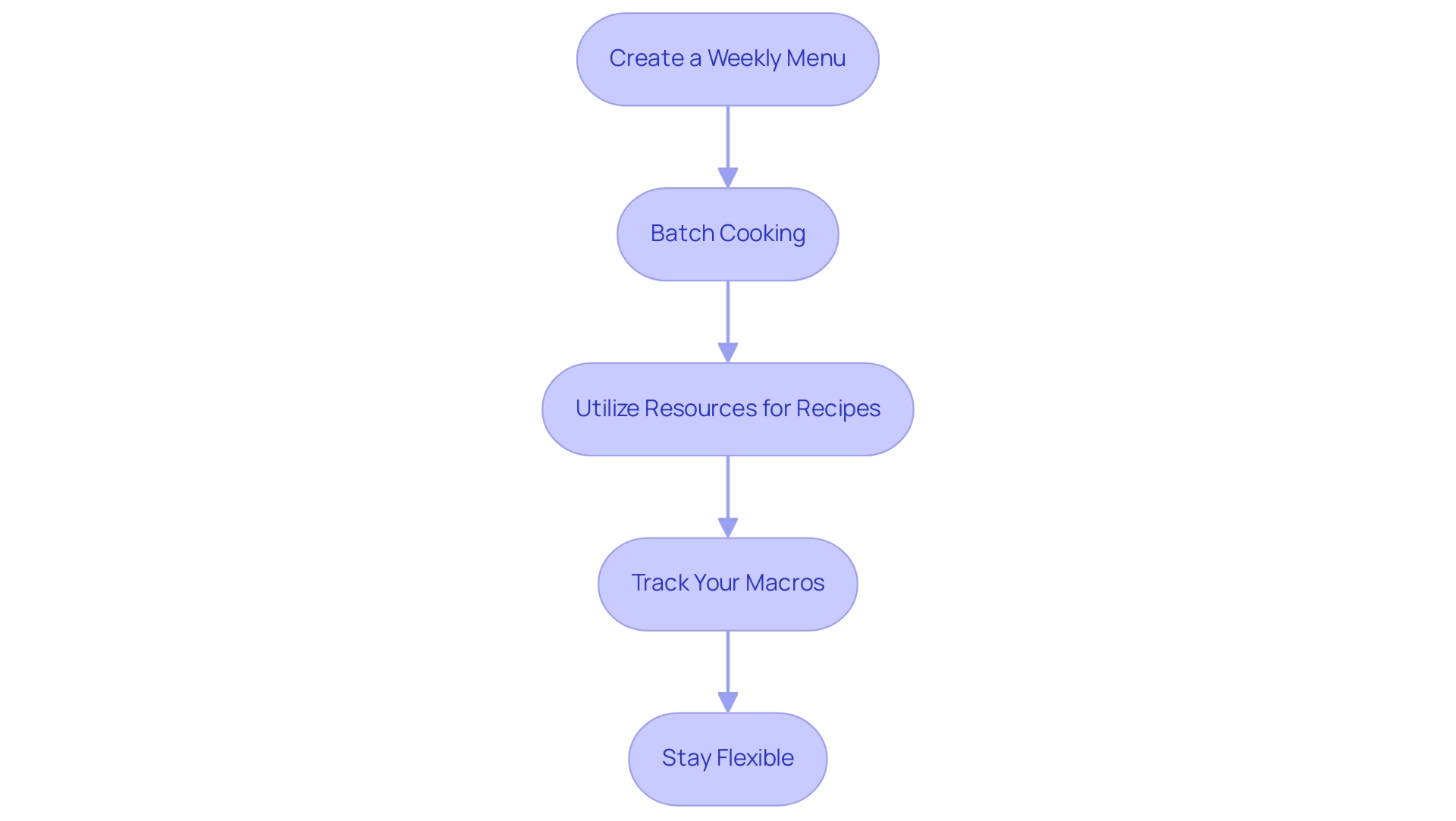
As you embark on your ketogenic journey, it is crucial to avoid these prevalent pitfalls:
-
Neglecting Electrolyte Balance: One of the most significant challenges when transitioning to a low-carbohydrate diet is maintaining proper electrolyte levels. An imbalance in sodium, potassium, and magnesium can lead to symptoms such as fatigue and headaches. Nutritionists emphasize the importance of balancing these minerals to support overall health and energy levels. As noted by expert Elisabeth Carlsson, "Support for Pots: balance minerals, improve hydration, and use natural techniques to restore energy and ease daily challenges." Incorporating these practices can help reduce the negative effects of keto flu and improve your overall experience on the keto diet.
-
Overeating Protein: While protein intake is vital, excessive consumption can disrupt ketosis. It's essential to maintain a balanced ratio of fats, proteins, and carbohydrates to achieve optimal results.
-
Ignoring Hidden Carbs: Processed foods often contain concealed sugars and carbohydrates that can hinder your progress. Always scrutinize nutrition labels, especially for sauces, dressings, and snacks, to avoid unintentional carb intake.
-
Not Drinking Enough Water: Adequate hydration is paramount on a low-carb eating plan. Aim for a minimum of 8 cups of water daily to facilitate metabolic processes and support overall well-being.
-
Giving Up Too Soon: Many beginners face challenges during the initial phases of the keto diet, which are commonly referred to as the 'keto flu.' It is vital to recognize that adaptation takes time and that persistence is essential for success. Real-world examples demonstrate that individuals who navigate these early difficulties often see substantial long-term benefits from the keto diet and its low-carbohydrate lifestyle. However, as highlighted in the case study on the sustainability of the low-carb eating plan, long-term adherence can be challenging, and understanding these obstacles is crucial for maintaining your nutritional changes.
Given that two-thirds of the adult population in Missouri is overweight or obese, the keto diet can be a valuable tool for weight management. By being aware of these typical errors, you can improve your likelihood of ongoing success on the low-carb eating plan.
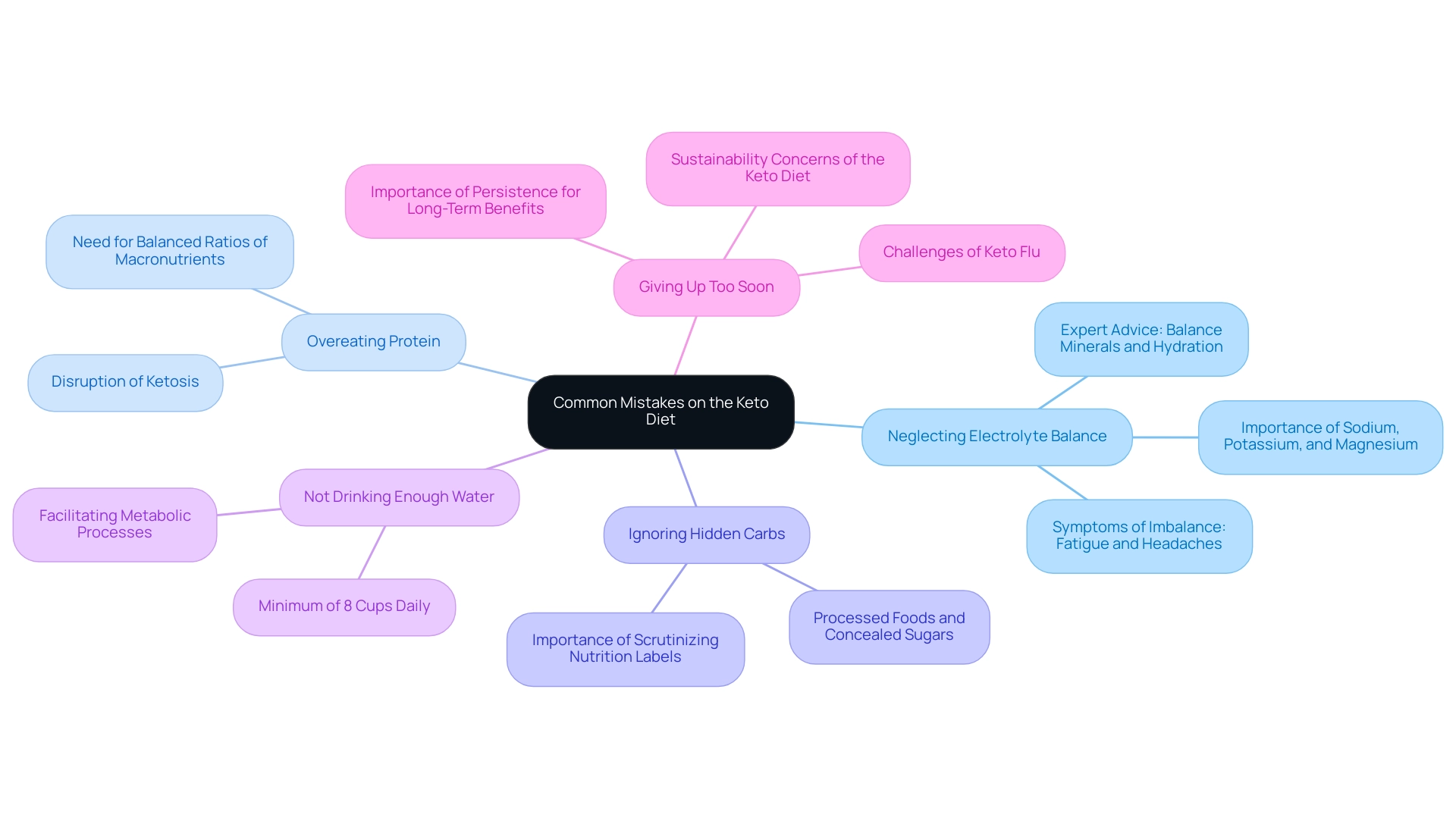
5. Monitoring Your Progress on the Keto Diet
To effectively monitor your progress on the low-carb eating plan, consider the following comprehensive methods:
- Weight Tracking: Weigh yourself weekly to observe changes over time. It is important to recognize that weight can fluctuate due to various factors; therefore, focus on overall trends rather than daily variations.
- Measurements: Conduct body measurements—such as those of the waist, hips, and chest—every few weeks. This practice can be more revealing than weight alone, especially when assessing fat loss.
- Ketone Testing: Employ ketone testing strips or a blood ketone meter to gauge your ketone levels. Monitoring these levels is crucial as it confirms whether you are in ketosis and how effectively your body is adapting to the keto diet. As noted by the Obesity Medicine Association, research demonstrates that the lowering of insulin levels on the keto diet dramatically improves diabetes and the factors associated with metabolic syndrome, making ketone testing an important tool for individuals monitoring their food intake.
- Athletic Performance Monitoring: If you are an athlete, note that studies indicate this eating approach does not negatively impact strength performance, showing no significant differences in strength or power compared to traditional meal plans. This can provide reassurance that your athletic performance can be maintained while following the keto diet.
- Journal Your Experience: Maintain a food and mood journal to reflect on how various foods influence your energy levels and overall well-being. This practice will provide valuable insights into which dietary choices work best for you.
- Set Goals: Establish both short-term and long-term health goals to sustain your motivation. Celebrating small victories along the way can enhance your enthusiasm and commitment to the nutritional plan.
In light of recent case studies, such as one examining a young man on a keto diet, it is evident that monitoring progress through lipid subfractions can provide a more nuanced understanding of cardiovascular risk, even amidst fluctuations in traditional cholesterol metrics. The case study revealed a substantial rise in total cholesterol; however, the patient's lipid profile enhanced with an increase in HDL-P, indicating that traditional lipid profile analyses may not accurately represent cardiovascular risk in patients following the keto diet. This highlights the importance of a holistic approach when tracking progress on the keto diet by incorporating various metrics and assessments.
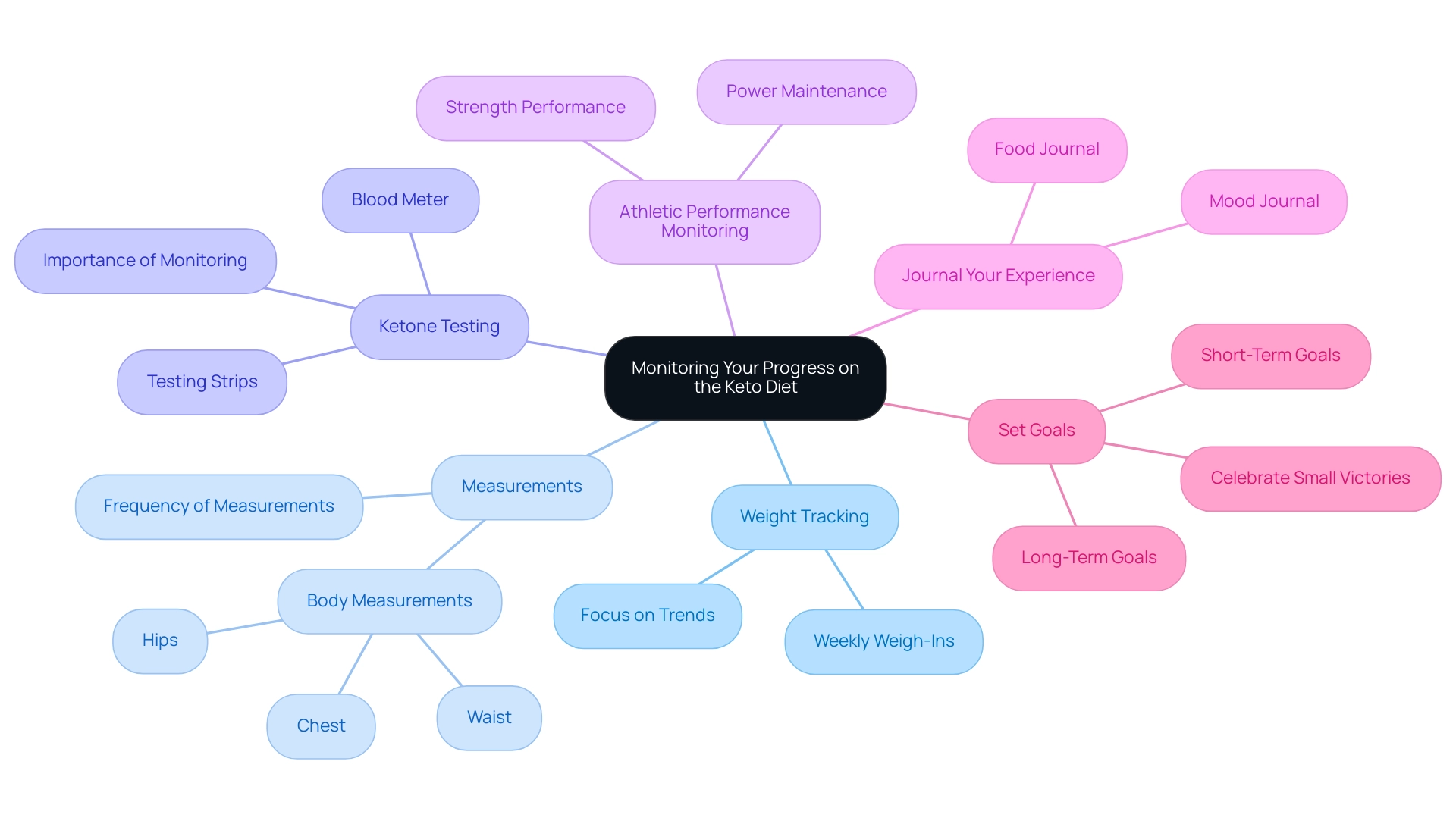
Conclusion
The ketogenic diet presents a unique approach to nutrition, centered on high-fat and low-carbohydrate intake that facilitates the body’s transition into ketosis. This metabolic state allows for efficient fat utilization, contributing to weight loss and potential health benefits. Understanding the dietary composition, essential food categories, and effective meal planning strategies is vital for anyone looking to adopt this lifestyle.
Incorporating nutrient-dense foods while avoiding high-carbohydrate options is crucial for maintaining ketosis. Strategic meal planning, including creating weekly menus and tracking macronutrient intake, ensures individuals stay on course. Awareness of common pitfalls such as:
- Electrolyte imbalances
- Hidden carbohydrates
- The importance of hydration
can further enhance the ketogenic experience. Monitoring progress through various methods, including weight tracking and ketone testing, provides valuable insights into individual responses to the diet.
Ultimately, the ketogenic diet offers a promising path for those seeking weight management and improved health outcomes. By adhering to the principles outlined, individuals can navigate their ketogenic journey with greater confidence and efficacy, unlocking the potential benefits of this dietary approach.





























